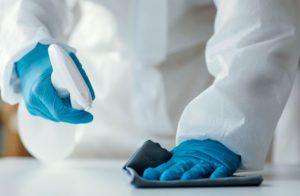
Disinfecting your house is of crucial importance when maintaining its cleanliness on a regular basis. Especially with the recent COVID-19 outbreak that brought attention to how important disinfection really is. Whenever you are taking care of any contaminated surfaces it is important to handle them correctly in order to avoid damage and further spreading of the germs. Another thing to keep in mind is the chemicals you are working with and how you use them. By not using certain methods properly, you may expose yourself and your family to health hazards.
Cleaning and disinfecting go hand in hand at all times. However, both of them are not the same and it is important to know the differences. While deep cleaning physically removes germs and bacteria from surfaces, it does not kill them. Disinfection neutralises all of them and prevents them from spreading and making you sick. Regularly treating high-traffic surfaces at home with disinfectant will keep your place germ-free and healthy as long as you avoid the common mistakes we will share with you. Keep reading to find out what those are and steer clear of them.
1. Using ineffective solutions – Make sure you use suitable products and chemicals for the job on hand. While soap and water will clean a surface, it will not kill bacteria. Eco-friendly products may not be strong enough to properly disinfect the area you are treating. To efficiently get rid of germs and bacteria, you should use a solution with a high alcohol percentage – 60% to 99%, such as rubbing alcohol. You can also use products containing bleach – 5-6% concentration of sodium hypochlorite. Those will instantly kill bacteria without leaving a sticky residue behind.
2. Mixing disinfectants – If you are running short on a disinfectant, you may be tempted to top off the bottle with a different kind of product. Depending on the solutions you are mixing, this could end up being a dangerous mistake. Mixing bleach with vinegar for example will release extremely toxic fumes that can be harmful to your eyes, nose, throat, etc. However, mixing liquid bleach and ammonia is an even more dangerous combination. That will create chloramine gas that can be extremely harmful, and even lethal. Generally, avoid mixing disinfectants of any kind. Label your bottles so you don’t accidentally do that.
3. Skipping pre-cleaning – Even if the surface you are about to treat seems clean, do not jump straight to disinfecting them. Washing these areas first will help disinfectants be more effective. Regular washing with soap and hot water will physically remove viruses and germs, as well as get rid of stuck-on grime, dirt, and stains. What is more, washing the surface prior to disinfecting will remove the fatty lipid layer that protects viruses.
4. Not using gloves – A lot of disinfectants, for example, the ones with a high alcohol percentage, can quickly dry out your skin, causing it to crack and bleed. The easiest way to avoid contact with the disinfecting product is by using disposable latex gloves. Put them on, finish the work, then toss them away. If you prefer to clean with reusable gloves, make sure to clean and disinfect them after each use. Wash the outside with hot water and soap while they are still on your hands. Remove the gloves, turn them inside out and let them soak in soapy water. Once they are clean inside and out, hang them to dry. Once dry, apply disinfectant to the outside of the gloves only. Applying it to the inside may end up damaging the skin on your hands.
5. Disinfecting food items – Consuming disinfectants can be dangerous and even lethal. Rubbing alcohol can cause dizziness, vomiting, intestinal bleeding, and even death. Bleach can also cause chest pain, delirium, nausea, and potentially death. When disinfecting your kitchen, make sure your food items are stored away in a cabinet or the refrigerator. That way you will avoid disinfectants ending up on their surface and exposing them to chemicals.
6. Reusing the cleaning rag – Using the same cloth for the disinfection of a number of surfaces is a bad habit. Even though the rag might be soaked in disinfectant, they are being dragged through some of the dirtiest places in your home. By using the same rag over and over again, you will simply spread the germs around. You can use disposable wipes or paper towels when disinfecting. However, if you prefer reusable cloths and rags, just get a bunch of them and use a clean one when switching to different areas of the house. When done, throw them in the washing machine and run the hottest cycle. It is also useful to get different coloured rags for the certain areas they are designated for. That way you will avoid cross-contamination and bring more order in your cleaning.
